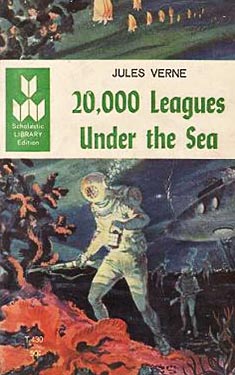Jules Verne
Completed 5/3/2020,
Reviewed 5/3/2020
3 stars
I haven’t
read many classics in my life. Since
beginning my genre fiction immersion about seven years ago, I’ve read several
of its classics. But this is my first Jules
Verne read. I read it for the ad hoc
online book club that’s been replacing the Powell’s Science Fiction Book Club which
has been suspended due to the pandemic.
I’m sorry to say that for the most part, I found it rather boring. It’s told in an episodic manner featuring
short scenes of action with lots of “wonder” filler in between. By that I mean that in between the action,
the narrator spends enormous amounts of pages describing undersea life, both inside
and outside the Nautilus, but mostly outside.
The narrator is constantly describing the marine biology: fish, mammals,
vegetation, crustaceans. In my opinion, I’d
say this was exceedingly popular when it was first published because it was a
relatively easy way for the general population to consume marine biology and
engineering. As a novel reading this one
hundred fifty years later, I have to say it’s not as exciting as I expected it
to be.
The plot is
straight forward. A scientist from the
museum of natural history is invited to join a ship in search of what is
assumed to be a giant narwhal, the species of whale with the unicorn-like
horn. It has been sinking ships, causing
near-panic around the world. During the
scurry that ensues between his ship and the presumed narwhal, the narrator Pierre,
his manservant Conseil, and the Canadian harpoon shooter Ned are thrown
overboard. They are saved by the narwhal,
which turns out to be Captain Nemo’s Nautilus.
Then they proceed to circumnavigate the globe, seeing the wonders of undersea
life. Along the way, they encounter
giant squid, icebergs and ice sheets, a hurricane, an undersea tunnel, and
other such exciting things. However, our
trio are told they can never leave the Nautilus lest they divulge the secret of
Nemo. Most of the second half of the
novel is our trio, particularly the impatient, aggressive Ned, looking for
opportunities to escape.
The narrator
is interesting. We learn that he is
quite a scholarly person, as he documents everything he sees on this trip
around the world. However, we don’t
really get much depth to his personality despite his narration. Ned, the Canadian harpoonist is much more
interesting. He’s a little hot-headed,
though he really doesn’t get into much trouble.
But we are told he is prone to violence.
This makes any interaction with him intriguing. I was always wondering when he was going to
go off on Nemo. I also liked Conseil. He was sort of like Samwise in The Lord of
the Rings. He was devoted to his master. We don’t spend much time with him, or with
Ned for that matter, but I enjoyed the scenes with them.
Captain Nemo
is distant and enigmatic. We don’t
really learn much about him except that he hates the world and has chosen to
live life under the sea to avoid people.
His crew is also made up of misanthropes. In the end though, we do get a glimpse of
what caused his misanthropy.
The
translation I read may not have been the best.
It was 288 pages long and was the free version from the Gutenberg
Project (though obtained through Amazon).
I don’t know who the translator was.
This translation though is said to be older and had parts left out that
the translator thought was boring or irrelevant. It used some archaic words like poulp, which
is a cephalopod such as a squid, octopus, or cuttlefish. It also had strange turns of phrases, like “the
disagreeable territory of Nebraska” which was later translated as “the Nebraska
Badlands”. I thought this was rather
funny. Having driven across Nebraska both
south to north and west to east, I’d say its badlands were rather disagreeable.
Hehe.
But overall, I didn’t mind the translation and since I thought the book
was on the boring side, I was not interested in reading the parts that had been
excised.
I give this
book three stars out of five. It was
fairly easy reading and wasn’t really too bad.
If Verne had written it today, I think it would have had a much
different form, rather than action – wonder – action – wonder – action. I think there would have been a healthier
plot. Verne was definitely prophetic in
that he saw submarines not powered by steam but by electricity. I’d be interested to read his other books to
see if they’re all the same format, like “From the Earth to the Moon”. But that’ll be after I get through my massive
TBR pile.

I read this for the first time around a decade ago, maybe slightly more recently, and I was so disappointed. I've read and loved several classics, and this one just felt like a slog for me, probably because the title and subject matter created an expectation in me. This book and Black Beauty, which I read to my daughter when she was in around first grade, are two classics that always come to mind when I think of classics that have disappointed me. And for both it is because I came to them with unrealistic expectations and would probably have read them differently had I a better clue what each was like.
ReplyDelete